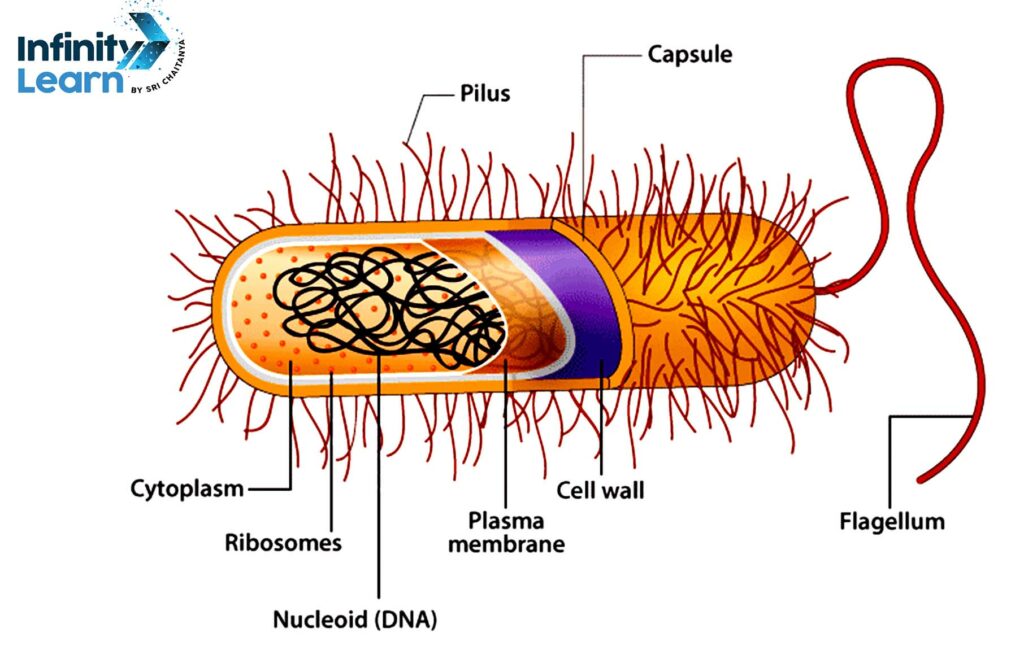Table of Contents
What is Bacteria?
Bacteria are extremely small, single-cell living beings. There are countless kinds of bacteria, many of which reside in and on your body, which is helpful. These bacteria create your microbiome, which maintains your body’s well-being. However, some bacteria can cause illnesses. Healthcare professionals can treat various bacterial infections using antibiotics.
Bacteria are tiny microorganisms that are made up of just one cell. The term for a single bacterium is “bacterium.” Numerous diverse kinds of bacteria exist all around the globe, and they’re also present in your body. They can be found on your skin, in your respiratory passages and mouth, as well as within your digestive, reproductive, and urinary systems. Scientists estimate that the number of bacterial cells in your body is around 10 times more than that of human cells.
Structure of Bacteria
Bacteria cell structure is straightforward. They are single-celled microorganisms characterized by the absence of a nucleus and other cell organelles, which classifies them as prokaryotes.
In addition, bacteria exhibit remarkable adaptability, thriving in even the harshest environments. Such resilient organisms are called extremophiles and are categorized based on their preferred habitats:
- Thermophiles: Flourish in high temperatures
- Acidophiles: Thrive in acidic surroundings
- Alkaliphiles: Prefer alkaline conditions
- Osmophiles: Survive in high-salt environments
- Barophiles: Adapted to high-pressure settings
- Cryophiles: Flourish in extreme cold.
Bacteria’s protective cell wall, composed of unique peptidoglycan protein, sets them apart. This distinctive feature forms the basis for classification. While some bacteria lack this wall, others possess a capsule for extra protection. External flagella and pili assist in movement and attachment. Bacteria lack complex organelles in animal or plant cells, with only ribosomes for protein synthesis. Certain bacteria also carry extra circular DNA known as plasmids, which can confer antibiotic resistance.
Bacteria Diagram
The provided diagram of a bacterial cell illustrates the components of a typical bacterial cell. It displays the cell wall, plasmid, cytoplasm, and flagella. The bacteria diagram is shown for easy understanding:

Classification of Bacteria
Bacteria can be categorized into different groups based on their characteristics. Their classification is primarily determined by the following:
- Shape
- Composition of the Cell Wall
- Mode of Nutrition
- Mode of Respiration
Here’s a breakdown of the classification:
| Shape Based Classification | |
| Type of Classification | Examples |
| Bacillus (Rodshaped) | Escherichia coli (E. coli) |
| Spirilla or spirochete (Spiral) | Spirillum volutions |
| Coccus (Sphere) | Streptococcus pneumoniae |
| Vibrio (Commashaped) | Vibrio cholera |
| Composition of the Cell Wall Based Classification | |
| Type of Classification | Examples |
| Peptidoglycan cell wall | Grampositive bacteria |
| Lipopolysaccharide cell wall | Gramnegative bacteria |
| Mode of Nutrition Based Classification | |
| Type of Classification | Examples |
| Autotrophic Bacteria | Cyanobacteria |
| Heterotrophic Bacteria | All disease-causing bacteria |
| Mode of Respiration Based Classification | |
| Type of Classification | Examples |
| Anaerobic Bacteria | Actinomyces |
| Aerobic Bacteria | Mycobacterium |
General Characteristics of Bacteria
Cell Structure:
- Lack of specialized parts like chloroplasts and mitochondria.
- Lack of a true nucleus found in complex cells (eukaryotic cells).
- DNA is circular and resides in the nucleoid, a region without a nuclear membrane.
- Possess cell membrane and cell wall, forming the cell envelope.
- Some cell walls are made of peptidoglycan, which is crucial for survival.
Reproduction:
- Reproduce through binary fission, splitting into two when they reach a certain size.
- Asexual reproduction results in daughter cells identical to the parent.
- Horizontal gene transfer: Some bacteria can swap genetic material with each other.
- Unlike parent-to-child transmission, this involves an exchange between existing bacteria.
Bacteria’s unique cellular structure and reproductive mechanisms contribute to their incredible adaptability and diversity.
Frequently Asked Questions on Bacteria
Define bacteria?
Bacteria are single-celled microorganisms with simple structures, lacking a true nucleus and membrane-bound organelles.
What are the general characteristics of bacteria?
Bacteria have diverse shapes, classifications based on cell wall composition, nutrition modes, and respiration types. They reproduce asexually through binary fission and can exchange genetic material.
How are bacteria classified?
Bacteria are categorized by shape, cell wall composition, nutrition, and respiration. Their simple structure includes a nucleoid and cell envelope, as a diagram depicts.
What are the different types of bacteria?
Bacteria vary by shape, cell wall, and nutrition, including bacillus, spirilla, cocci, gram-positive, gram-negative, autotrophic, and heterotrophic types.
Can you explain the structure of bacteria?
Bacteria have nucleoids with circular DNA, lack membrane-bound organelles, and feature cell envelopes with membranes and often peptidoglycan cell walls. Reproduction is through binary fission, shown in a bacteria diagram.








